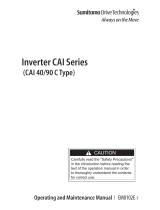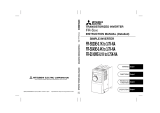
A-1
This Instruction Manual (Basic) provides handling information and precautions for use of the equipment.
Please forward this Instruction Manual (Basic) to the end user.
4. Additional Instructions
Also the following points must be noted to prevent an accidental failure, injury,
electric shock, etc.
This section is specifically about safety matters
Do not attempt to install, operate, maintain or inspect the inverter
until you have read through this Instruction Manual (Basic) and
appended documents carefully and can use the equipment
correctly. Do not use the inverter until you have a full knowledge of
the equipment, safety information and instructions. In this
Instruction Manual (Basic), the safety instruction levels are
classified into "WARNING" and "CAUTION".
Incorrect handling may cause hazardous
conditions, resulting in death or severe injury.
Incorrect handling may cause hazardous
conditions, resulting in medium or slight
injury, or may cause only material damage.
The level may even lead to a serious consequence
according to conditions. Both instruction levels must be followed
because these are important to personal safety.
1.Electric Shock Prevention
While the inverter power is ON, do not open the front cover or
the wiring cover. Do not run the inverter with the front cover or
the wiring cover removed. Otherwise you may access the
exposed high voltage terminals or the charging part of the
circuitry and get an electric shock.
Even if power is OFF, do not remove the front cover except for
wiring or periodic inspection. You may accidentally touch the
charged inverter circuits and get an electric shock.
Before wiring, inspection or switching EMC filter ON/OFF
connector, power must be switched OFF. To confirm that, LED
indication of the operation panel must be checked. (It must be
OFF.) Any person who is involved in wiring, inspection or
switching EMC filter ON/OFF connector shall wait for at least 10
minutes after the power supply has been switched OFF and
check that there are no residual voltage using a tester or the like.
The capacitor is charged with high voltage for some time after
power OFF, and it is dangerous.
This inverter must be earthed (grounded). Earthing (grounding)
must conform to the requirements of national and local safety
regulations and electrical code (NEC section 250, IEC 536 class
1 and other applicable standards). A neutral-point earthed
(grounded) power supply for 400V class inverter in compliance
with EN standard must be used.
Any person who is involved in wiring or inspection of this
equipment shall be fully competent to do the work.
The inverter must be installed before wiring. Otherwise you may
get an electric shock or be injured.
Setting dial and key operations must be performed with dry
hands to prevent an electric shock. Otherwise you may get an
electric shock.
Do not subject the cables to scratches, excessive stress, heavy
loads or pinching. Otherwise you may get an electric shock.
Do not replace the cooling fan while power is ON. It is
dangerous to replace the cooling fan while power is ON.
Do not touch the printed circuit board or handle the cables with
wet hands. Otherwise you may get an electric shock.
When measuring the main circuit capacitor capacity (Pr. 259 Main
circuit capacitor life measuring = "1"), the DC voltage is applied to
the motor for 1s at powering OFF. Never touch the motor terminal,
etc. right after powering OFF to prevent an electric shock.
IPM motor is a synchronous motor with high-performance
magnets embedded in the rotor. Motor terminals hold high-
voltage while the motor is running even after the inverter power
is turned OFF. Before wiring or inspection, the motor must be
confirmed to be stopped. When the motor is driven by the load in
applications such as fan and blower, a low-voltage manual
contactor must be connected at the inverter's output side, and
wiring and inspection must be performed while the contactor is
open. Otherwise you may get an electric shock.
2. Fire Prevention
Inverter must be installed on a nonflammable wall without holes
(so that nobody touches the inverter heatsink on the rear side,
etc.). Mounting it to or near flammable material can cause a fire.
If the inverter has become faulty, the inverter power must be
switched OFF. A continuous flow of large current could cause a
fire.
Do not connect a resistor directly to the DC terminals P/+ and N/
-. Doing so could cause a fire.
Daily and periodic inspections must be performed as instructed
in the Instruction Manual. If the product is used without receiving
any inspection, it may cause a burst, break, or fire.
3. Injury Prevention
The voltage applied to each terminal must be the ones specified in
the Instruction Manual. Otherwise burst, damage, etc. may occur.
The cables must be connected to the correct terminals.
Otherwise burst, damage, etc. may occur.
Polarity must be correct. Otherwise burst, damage, etc. may
occur.
While power is ON or for some time after power-OFF, do not
touch the inverter since the inverter will be extremely hot. Doing
so can cause burns.
(1) Transportation and installation
The product must be transported in correct method that
corresponds to the weight. Failure to do so may lead to injuries.
Do not stack the boxes containing inverters higher than the
number recommended.
The product must be installed to the position where withstands
the weight of the product according to the information in the
Instruction Manual.
Do not install or operate the inverter if it is damaged or has parts
missing. This can result in breakdowns.
When carrying the inverter, do not hold it by the front cover or
setting dial; it may fall off or fail.
Do not stand or rest heavy objects on the product.
The inverter mounting orientation must be correct.
Foreign conductive objects must be prevented from entering the
inverter. That includes screws and metal fragments or other
flammable substance such as oil.
As the inverter is a precision instrument, do not drop or subject it
to impact.
The inverter must be used under the following environment:
Otherwise the inverter may be damaged.
*1 Temperature applicable for a short time, e.g. in transit.
*2 2.9m/s
2
or less for the 185K or higher.
If halogen-based materials (fluorine, chlorine, bromine, iodine,
etc.) infiltrate into a Mitsubishi product, the product will be
damaged. Halogen-based materials are often included in
fumigant, which is used to sterilize or disinfest wooden packages.
When packaging, prevent residual fumigant components from
being infiltrated into Mitsubishi products, or use an alternative
sterilization or disinfection method (heat disinfection, etc.) for
packaging. Sterilization of disinfection of wooden package should
also be performed before packaging the product.
Environment
Surrounding air
temperature
-10°C to +50°C (non-freezing)
Ambient humidity 90% RH or less (non-condensing)
Storage temperature -20°C to +65°C
*1
Atmosphere
Indoors (free from corrosive gas, flammable
gas, oil mist, dust and dirt)
Altitude, vibration
Maximum 1000m above sea level for
standard operation. 5.9m/s
2
*2 or less at 10
to 55Hz (directions of X, Y, Z axes)























